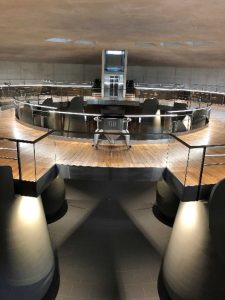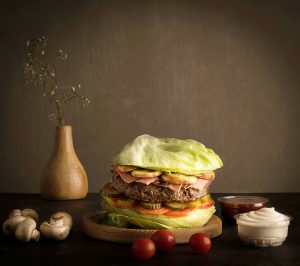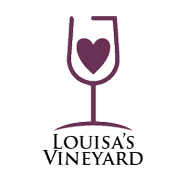Relaxing with a glass of wine is no longer the same for me. I see things differently because I’ve researched vineyards and wineries so my books will be authentic. When I lift a glass, check the color, sniff the wine (sorry, I really don’t want to drink wine that tastes like tobacco or dirt!), and savor the flavor, I think of the many steps it takes to cultivate grapes and turn them into wine!

Since I’m featuring vineyards in my Louisa’s Vineyard Series, my trip to France focused on visiting vineyards in Bordeaux. My first visit was to Chateau Haut-Bailly, a long-established, award-winning vineyard and winery that has modernized, but also follows some long-standing practices.
I had the great pleasure of touring the grounds and facilities with Manon Drougard, who answered my endless questions. Their inspired facility includes some of the former marine life─ from eons ago─that are beneath the current terroir (the soil with all its nuances, from sand, rocks, and clay.) “The vineyard offers an incomparable patchwork of plots suited to the needs of Cabernet Sauvignon, Merlot, Cabernet Franc, Petit Verdot, Malbec and Carménère.” (Quote from the Haut-Bailly website.)
Manon walked us to the vineyard, which encompassed a special area where the vines are mixed varieties of grapes. Under the direction of Véronique Sanders, a member of the family who has owned the vineyard for three generations, she “listens to nature” by watching how the grapes grow and reacting to the weather cycles. They even tag the individual vines that are not ready to be harvested yet with a red ribbon. I asked Ms. Sanders if she ever took vacations, since she appeared to be on hand to make decisions that could affect the harvest and the well-being of the vines.
Her answer, “Not often.”

A mixture of revered practices and new ideas, Haut-Bailly still keeps four plots of vines that are planted with mixed grapevines. Their vines average forty years old. In their four hectares (a hectare equals 4.71 acres) plot, they have a mix of grape varieties planted in rows, which follow an approach of harvesting all the vines together, then using that as their mix.
Modern plantings keep all of one variety together. The vintners decide how the wine will be mixed to achieve their desired final product.
Nature provides challenges. At the end of many rows of vines, the traditional approach is to plant a red rose bush as a test to see if mildew or disease is a problem, much like a canary brought in a mine to see if it’s safe. If the rose bush can’t survive, it’s likely that the vines may have the same issues. Their area of Bordeaux is rainy, which can cause mildew.
In France, it is illegal to water grape vines older than three years. That adds to Haut-Bailly challenges. Haut-Bailly favors quality over quantity in their production. They also harvest by hand.

All these challenges don’t take into consideration the fermenting, aging, and bottling processes. Haut-Bailly now uses a modernized wine cave, tucked into landscaping and almost unnoticeable. The design for the cave includes stainless steel tanks, as well as concrete “eggs,” where wine is stored and tested, until it’s ready for barrels and aging. The wine cave is so modern and attractive that they have even held customers events there. One innovation built into the concrete tanks is lighting inside. Typically, workers who clean the empty tanks in other vineyards must bring lighting with them.
RESULTS
Once it’s ready to bottle, the wine is labeled with either “Haut-Bailly” (GRAND CRU CLASSÉ) or “Haut-Bailly II” (GRAND VIN DE BORDEAUX). Cabernet Sauvignon, more complex and aged longer, is 56% of their Haut-Bailly label. Merlot is 30%. For their younger, lower price point wine, Haut-Bailly II label, 60% is Merlot and 40% Cabernet Sauvignon. All of their vintages are red wines. They do have other blends, but the Chateau Haut-Bailly wines are the ones winning awards, on menus locally, and most prominently known. They are also producing Château Le Pape wine.

I‘ve tried both levels of wine and I preferred the Haut-Bailly II wine, since I usually drink white wine.
(More about a different vineyard with a different approach in my next column.)

BONUS BLOG: BURGERS, BUNS, AND INSURRECTION
For anyone who learned elementary French, two words you probably know are “avec,” meaning “with” and “sans,” meaning “without.” Once you understand those words, you can usually order in a restaurant with the menu to assist you.
At the Novotel Hotel in Bordeaux where we stayed, the property includes an outside restaurant, the Hippopotamus Restaurant, a steakhouse. Why Hippopotamus Restaurant as a steakhouse? No one seems to know. But they have an extensive menu with many items beyond just steaks, (fish, vegetarian, and hamburgers, etc.)
Audaciously, I asked the wait staff member for a particular hamburger “sans”–without–the bun. The restaurant served burgers on a rectangular piece of slate, so that was not an impossible request.
The staff member stood still, mouth open in shock for at least a minute, a long pause in restaurant time. She looked at me questioningly, “Sans?”
My response, “Oui, sans bun.”
Still in shock, she nodded slowly, absorbing the concept. She didn’t seem convinced that “sans” could be produced. She disappeared.
Finally, she returned with our meals on the slates. I thanked her profusely. And mine was without, sans, a bun.
I had no idea that asking for a hamburger without a bun could create an international incident! The hamburger with its many accompaniments was a very filling meal, even without the bun. I was not just arbitrarily asking her to break custom. Buns have wheat. Wheat is not my friend. ‘Nuff said on that.
The wait staffer looked at me differently after that. Like maybe I was strange, or she was afraid of what else I might ask for!
I’ve never considered myself a revolutionary, but I’ve often been an innovator. Considering what happened in Paris in 1789 (for those not familiar with history–the French Revolution, and the guillotine – “off with their heads!”) I wondered if I needed to be careful what I asked for. We hadn’t stayed in Paris yet, other than to travel from the airport to transfer to trains heading to Bordeaux.
 My ancient knowledge of French includes just a few questions. I hoped that asking for a hamburger without a bun or ANYTHING different would not strain French and American relations. Online French refresher courses stated that the words “Bon jour” were essential to a conversation. After just a few days, I had people furious with me for getting in a line to sit and eat without understanding why they were angry. The woman epitomized the expression, “If looks could kill.” And, of course, I’d forgotten to smile and say, “Bon Jour.”
My ancient knowledge of French includes just a few questions. I hoped that asking for a hamburger without a bun or ANYTHING different would not strain French and American relations. Online French refresher courses stated that the words “Bon jour” were essential to a conversation. After just a few days, I had people furious with me for getting in a line to sit and eat without understanding why they were angry. The woman epitomized the expression, “If looks could kill.” And, of course, I’d forgotten to smile and say, “Bon Jour.”
Luckily, someone spoke English and explained my transgression. We walked three blocks to a park where we could sit down and eat our rapidly cooling fast food. Only the birds bothered us.
NEXT TIME: More observations on our travels in France and England.
